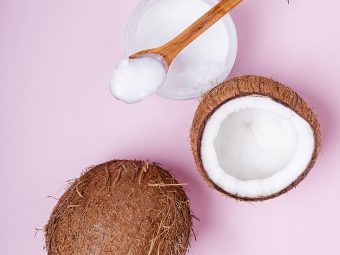Castor Oil For Eyebrows & Eyelashes: How To Use & Side Effects
Use this oil with a variety of ingredients to boost your brow and lash growth!

Image: Shutterstock
Not all of us are born with thick and beautiful eyebrows, but that does not mean you cannot get the eyebrow thickness that you desire! There is a natural solution. You can use castor oil for enhanced eyebrow health. This is a popular home remedy for everyone who longs for power brows like Cara Delevingne.
Most beauty bloggers recommend castor oil for thickening of brows and lashes. However, let us find out if this claim has any scientific merit. Keep reading!
In This Article
Does Castor Oil Help Your Eyebrows And Eyelashes Grow?
Castor oil is extracted from the seeds of the castor or Ricinus communis plant. The seeds, also called castor beans, contain ricin, which is a toxic enzyme. However, after processing, this toxin is deactivated, and the oil is safe to use.
Over the years, castor oil has gained the reputation of being the panacea for hair loss. Does it really work?
There hasn’t been enough research on the effectiveness of castor oil in promoting hair growth, strengthening hair follicles, and preventing hair fall or loss.
However, ricinoleic acid, a chemical compound that constitutes about 90% of the oil, may help you deal with hair loss (from your eyebrows, lashes, and scalp) (1).
A study involving men with androgenic alopecia (male pattern baldness) found that they had high levels of prostaglandin D2 or PGD2 in the scalp. This enzyme inhibits hair growth (2).
In another study, researchers found that ricinoleic acid could inhibit PGD2 and help in hair loss treatment (3).
Anecdotal evidence has mixed reviews. For some people, castor oil has a nourishing effect and works like magic to promote hair growth, while others don’t notice any dramatic changes. Nonetheless, it continues to be a popular cosmetic oil in natural beauty routines. If you want to go ahead and give it a try, here are a few ways you can use it to get thick eyebrows and great eyelashes.
Little Latina, a YouTuber, shared her experience of using castor oil to grow her eyelashes. She said, “My eyelashes look so good with them. It brought them so much growth. So much thickness and really rejuvenated them. It gave them the length that they were missing (i).”
But before we get to the remedies, let’s first understand what type of castor oil can help you in this process.
Which Type Of Castor Oil Is Best For The Eyebrows And Eyelashes?
It is not unusual to feel overwhelmed by the sheer number of choices the market has to offer. However, picking just any castor oil will not give you the desired results. Most of the commercially available castor oils contain additives and other oils, which might cause irritation and may not give you the desired results. Hence, pick only:
- Cold-pressed castor oil, and
- Jamaican black castor oil (extracted from roasted castor seeds)
These two types of oils retain natural antioxidants, have similar properties, and can promote hair growth. Now, let’s see how you can use castor oil in your eyelash and eyebrow care routine.
How To Use Castor Oil For Your Eyebrows And Eyelashes
You may apply pure castor oil to your eyebrows and eyelashes. However, pure castor oil is too thick. If you do not like the sticky consistency, you may mix it with other ingredients (as described in the recipes) and use it.
 Quick Tip
Quick TipCastor Oil for Eyebrows
1. Castor Oil And Vaseline
You Will Need
- 1 teaspoon castor oil
- ½ teaspoon Vaseline
- 1 spoolie brush or Q-tip
- 1 bowl
Method
- Mix both ingredients in a bowl until you get a smooth paste.
- Dip the spoolie brush or Q-tip into the mixture.
- Apply it thoroughly on your eyebrows. Make sure it does not drip.
- Leave it on overnight.
- Wash the next day.
How Often?
Every night.
2. Castor Oil And Aloe Vera For Eyebrows
You Will Need
- 1 tablespoon castor oil
- 1 tablespoon aloe vera gel
- 1 spoolie brush or Q-tip
- 1 bowl
Method
- Mix the ingredients thoroughly in a bowl.
- Dip the spoolie brush or Q-tip into the mixture.
- Apply it on your eyebrows.
- Leave it on overnight and wash off the next morning.
How Often?
Every night.
3. Castor Oil And Glycerin For Eyebrows
You Will Need
- 1 tablespoon castor oil
- ½ teaspoon glycerin
- 1 spoolie brush or Q-tip
- 1 glass jar
Method
- Mix the ingredients and store the mixture in the glass jar.
- Dip the spoolie brush or Q-tip into the mixture.
- Apply it thoroughly on your eyebrows.
- Leave it on overnight.
- Wash off the next morning.
How Often?
Every night.
4. Castor Oil And Rosemary Oil
You Will Need
- 1 tablespoon of castor oil
- 1-2 drops of rosemary essential oil
- 1 spoolie brush or Q-tip
- 1 glass jar
Method
- Mix both the oils in the glass jar.
- Use a spoolie brush or Q-tip to apply the mixture to your eyebrows.
- Leave it on overnight.
- Wash it off in the morning.
How Often?
2-3 times a week
 Did You Know?
Did You Know?Castor Oil for the Eyelashes
1. Pure Castor Oil
You Will Need
- Castor oil (enough for the lashes)
- 1 spoolie brush or mascara wand
Method
- Dip the spoolie brush into the castor oil.
- Apply castor oil to your eyelashes the way you would apply mascara. Be careful not to get the oil in your eyes.
- Apply on the upper as well as lower lashes.
- Leave it on overnight.
- Wash it off the next day.
How Often?
Every night.
2. Castor Oil And Almond Oil
You Will Need
- 1 tablespoon almond oil
- 1 tablespoon castor oil
- 1 spoolie brush
- 1 glass jar
Method
- Pour the oils into the glass jar and mix well.
- Dip the spoolie brush into the jar.
- Apply the oil blend on both the upper and lower lashes.
- Leave it on overnight.
- Wash off the next day.
How Often?
Every night.
3. Castor Oil And Olive Oil
You Will Need
- 1 tablespoon castor oil
- 1 tablespoon olive oil
- 1 spoolie brush
- 1 glass jar
Method
- Pour the oils in the jar and mix well.
- Dip the spoolie brush and coat your lashes with the oil mixture (both eyelids).
- Leave it on overnight.
- Wash off the next day.
How Often?
Every night.
4. Castor Oil And Coconut Oil
You Will Need
- 1 tablespoon of castor oil
- 1 tablespoon of coconut oil
- 1 spoolie brush
- 1 glass jar
Method
- Pour the oils into a glass jar and mix well.
- Use a spoolie brush to apply the oil to your eyelashes carefully.
- Leave it on overnight.
- Wash it off the next morning with lukewarm water.
How Often?
3 times a week
While using castor oil may sound promising, it is also important to note that it has some side effects. Since the efficacy of castor is mostly anecdotal, you need to be careful while using it on your skin. Here are a few points to consider.
Castor Oil: Possible Side Effects And Things To Remember Before Using
Castor oil is generally non-toxic, but it may cause an allergic reaction. It may result in:
- Itching
- Swelling
- Skin rashes
- Redness
These are the commonly reported issues. If you experience any skin reactions, discontinue using castor oil and consult a dermatologist.
To avoid these side effects, make sure you:
- Do a patch test before using castor oil.
- Start slowly. Use a small amount of the oil on your skin and then increase the amount gradually as your skin starts getting accustomed to it.
- Buy only pure, cold-pressed castor oil and not the ones with additives. Often, the additives may also cause skin irritation.
- Consult a dermatologist before using castor oil on your skin, especially if you have any skin issues (such as dermatitis).
- Don’t use castor oil without consulting a dermatologist if you have sensitive or acne-prone skin.
Infographic: DIY Castor Oil Remedies For Eyelashes
Since castor oil doesn’t contain any potentially harmful compounds, it can be used directly. However, this oil can also be mixed with other components to maximize the benefits. Check out the infographic below for some DIY eyelash remedies with castor oil. Illustration: StyleCraze Design Team
Many individuals swear by castor oil for eyelash and eyebrow maintenance. It contains important bioactive ingredients, essential fatty acids, vitamin E, and minerals that promote the growth of healthier eyebrows. You can combine castor oil with petroleum jelly or glycerin and use a mascara wand to apply it to your eyebrows. While it may not give sure-shot results, there is no harm in trying. More research is needed to understand its benefits. However, anecdotal evidence suggests that you can apply moderate amounts of it to your eyebrow. If you experience any adverse effects, limit its use and seek medical advice.
Frequently Asked Questions
How long does it take for castor oil to work on eyebrows?
As per anecdotal evidence, using castor oil on eyebrows may show positive results in 4-6 weeks.
Is Vaseline or castor oil better for eyelashes?
As per anecdotal evidence, castor oil is better for eyelashes. Vaseline (petroleum jelly) does not support lash growth. However, you may use them together for their moisturizing benefits for your lashes. Vaseline can act as a sealant to lock castor oil in and let it do its job. However, do a patch test before using castor oil and ensure it does not gets into your eyes.
Can castor oil help with filling in sparse areas of the eyebrows?
Since castor oil may help boost hair growth, it may aid in filling in the sparse areas of the eyebrows (5). However, conduct a patch test before use to ensure there are no allergic reactions.
Should I cleanse my eyebrows before applying castor oil?
Yes, it is best to thoroughly clean and wash the eyebrows before applying castor oil for effective results.
Key Takeaways
- The ricinoleic acid in castor oil may help grow thicker and longer eyebrows.
- You can leave castor oil alone or combine it with aloe vera or glycerin every night to promote hair growth in your eyebrows.
- Constant usage of castor oil may cause redness, skin rashes, or itching in some people.
- Always use cold-pressed castor oil in small amounts to allow your skin to get used to it.

Image: Stable Diffusion/StyleCraze Design Team
References
Articles on StyleCraze are backed by verified information from peer-reviewed and academic research papers, reputed organizations, research institutions, and medical associations to ensure accuracy and relevance. Read our editorial policy to learn more.
- Castor oil and Chemistry, CasChem.
https://www.chem.uwec.edu/chem491_w01/%20Pharmacognosy%20491/castor%20bean%20chemistry.pdf - Prostaglandin D2 Inhibits Hair Growth and Is Elevated in Bald Scalp of Men with Androgenetic Alopecia, Science Translational Medicine, US National Library of Medicine, National Institutes of Health.
https://www.ncbi.nlm.nih.gov/pmc/articles/PMC3319975/ - In silico prediction of prostaglandin D2 synthase inhibitors from herbal constituents for the treatment of hair loss, Journal of Ethnopharmacology, ScienceDirect.
https://www.sciencedirect.com/science/article/pii/S0378874115301677?via%3Dihub - Jarilla–Coffee Extract: A Natural Cosmetic Product That Improves Eyelash And Eyebrow Growth In Women, Clinical, Cosmetic, and Investigational Dermatology, US National Library of Medicine, National Institutes Of Health
https://www.ncbi.nlm.nih.gov/pmc/articles/PMC6330964/
































